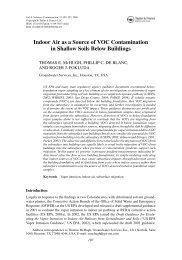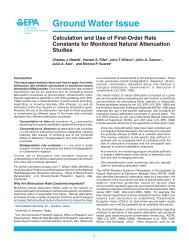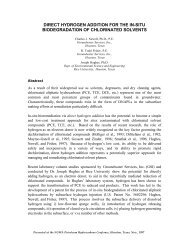Passive Soil Vapor Extraction - GSI Environmental Inc.
Passive Soil Vapor Extraction - GSI Environmental Inc.
Passive Soil Vapor Extraction - GSI Environmental Inc.
- No tags were found...
You also want an ePaper? Increase the reach of your titles
YUMPU automatically turns print PDFs into web optimized ePapers that Google loves.
SRNL-STI-2009-00571Rev. 1of the valve when closed and easy opening during outflow pressure events. Presence ofdirt or insects can interfere with the sealing of the ball/flapper and result in some leakageof ambient air into the well during inflow events. In general, this condition corrects itselfduring subsequent outflow events.2.3.2 MicroBlower ApplicationsThe MicroBlower assembly requires basic house-keeping to ensure effective long-termoperation - cleaning of the pumps, dusting of the solar panels or maintenance of thewind generators. Current field experience with systems using solar panels as the energysource indicates that the O & M requirements for the MicroBlowers are minimal.2.4 Long-Term Monitoring for PSVE ApplicationsIn general, an effective SVE monitoring program should involve periodic collection ofdata necessary to estimate contaminant mass flux as well as evaluate the progress ofremediation by SVE. Mass flux (units - kg/yr) can be calculated based on fieldmeasurements of the soil gas extraction rates and VOC concentrations in the extractedgas. Remedial progress within the zone of influence of the extraction well can beestimated using results from a rebound test performed at regular intervals during thecourse of the SVE program. See Site Example 1 in grey box for a description of themethod used at the MAPSL site, SRS, SC to demonstrate the effectiveness of a PSVEapplication.2.4.1 Estimation of Contaminant Mass FluxThe average contaminant mass flux (kg/yr) can be calculated by multiplying the averageVOC concentrations measured in the extracted soil gas by the estimated average soilgas flow rates.Measurement of VOC Concentrations in <strong>Soil</strong> Gas: Field equipment capable ofmeasuring both the VOCs and CO 2 e.g. Infra-red Photo-Acoustic Spectroscopy (IRPAS)should be used in order to determine the average VOC concentrations in the soil gas.Measuring the CO 2 concentrations in the extracted soil gas is necessary to ensure thatextracted gas is from the subsurface target zone and is not being short circuited from thesurface. Alternatively, samples may be collected in Tedlar bags, summa canisters orglass vials and analyzed using standard methods.Measurement of <strong>Soil</strong> Gas Flow Rates: Due to the intermittent nature of the barometricpumping technology, the use of continuous flow data logging systems to measure soilgas flow within the vent well is generally recommended for at least some wells in abarometric extraction system. Wells must be temporarily sealed to accurately measurethe subsurface pressure. Once the relation between surface pressure fluctuations andsubsurface pressure (and ultimately flow through the well) have been established bymonitoring, the flow response to surface pressure fluctuations can be accuratelypredicted by analytical models (Rossabi and Falta, 2002).14 Enhanced Attenuation Technologies<strong>Passive</strong> <strong>Soil</strong> <strong>Vapor</strong> <strong>Extraction</strong>






